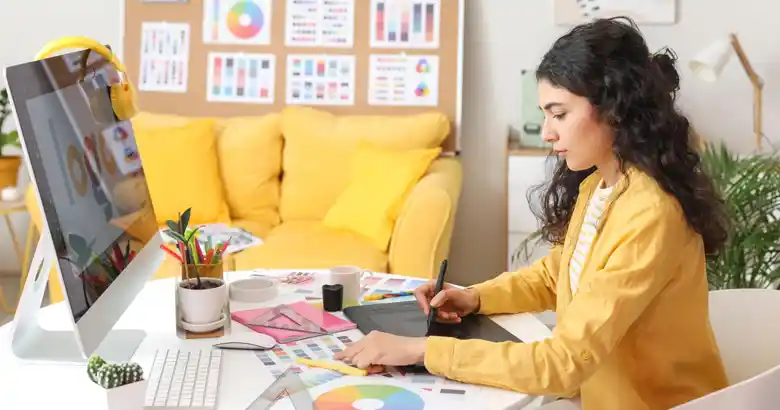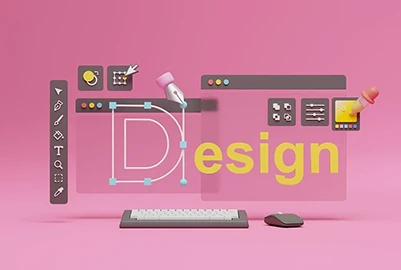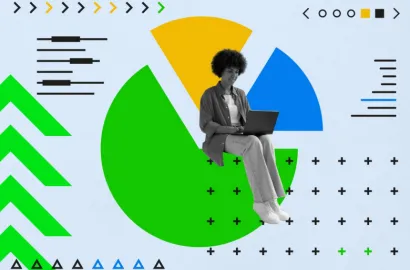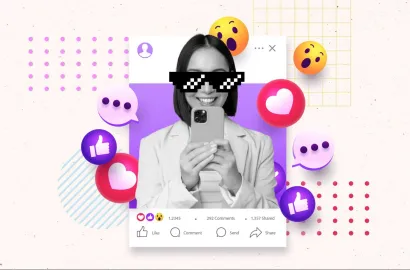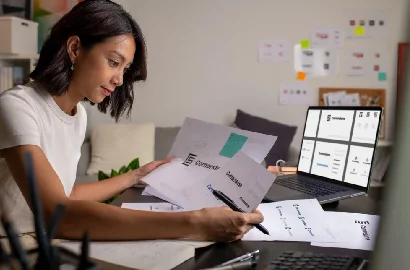Are you considering a career in graphic design but not sure where to start? Discover how to become a graphic designer in this step-by-step guide.
You want a creative, varied, and in-demand job that pays well. You also love the idea of making an impact, as well as helping businesses and brands to succeed. No wonder you’ve landed on graphic design as a potential career path!
So now you’re wondering…do I have what it takes? What skills and qualifications do I need to break into this exciting field? How do I get started on the graphic design ladder? Should I pursue a graphic design course?
You’ve got questions, and we’re here to answer them. In this guide, we lay out exactly what you need to become a graphic designer—including practical steps you can follow to make it happen.
- 1) What does a graphic designer do?
- 2) Why become a graphic designer?
- 3) What skills and qualifications do you need to be a graphic designer?
Before you make any moves toward becoming a graphic designer, it’s important to understand what a graphic designer does. This will give you crucial insight into what skills you need to learn and why.
So let’s begin by exploring what the role of a graphic designer entails.
What does a graphic designer do?
You likely already know that graphic design is a creative, artistic discipline. But graphic designers don’t create art for art’s sake; they design with the goal of bringing a concept to life, communicating an idea or a message, and connecting with a particular target audience.
As such, graphic designers are experts in visual communication.
The exact role of a graphic designer depends on their industry or niche. There are many different types of graphic design—branding and visual identity, graphic design for marketing, digital design, editorial and print, and packaging design, to name a few. Each requires its own unique skills, tools, and processes.
Despite these variations, all graphic designers use the same basic elements (shapes, lines, colour, type, and so on) and adhere to the same fundamental principles (balance, contrast, proportion, etc). They also all follow some version of the graphic design process, which includes:
- Defining project briefs, usually in collaboration with clients and key stakeholders.
- Conducting research to understand the market and the target audience, and to gather inspiration.
- Brainstorming ideas, fine-tuning the concept, and pitching ideas for early feedback.
- Designing the final deliverable(s).
- Gathering more client and/or stakeholder feedback and iterating on designs.
- Implementing feedback, finalising the designs, and handing over the final deliverables.
Within this high-level process, the main tasks of a graphic designer can be broken down as follows:
- Developing design concepts and determining project specifications.
- Pitching ideas to clients and stakeholders, creating mood boards.
- Designing individual assets such as illustrations, icons, and logos.
- Choosing colour palettes and typography.
- Sourcing or shooting photos and videos, sourcing stock images.
That’s the role of a graphic designer in a nutshell. As you can see, graphic designers are collaborative, creative, and detail-oriented. They’re also highly versatile, taking on a broad spectrum of tasks.
Now we know what a graphic designer does, let’s consider why this is such an appealing career path.
Why become a graphic designer?
This is an easy one! There are many compelling reasons why you might choose to become a graphic designer—from high demand and good earning potential, right through to overall job satisfaction.
Here’s why graphic design is a popular career choice:
- Graphic designers are in demand. According to freelancing platform Upwork, graphic design is the most in-demand creative skill for 2023. Generally speaking, the graphic design industry is growing at a steady rate, with the US Bureau of Labor Statistics projecting a 3% increase in demand for graphic designers between 2021 and 2031. In India, the design industry is growing at a rate of 23-25% each year. In short, graphic design represents a secure and stable career path.
- Graphic designers make decent money. The average salary for a graphic designer in India ranges from around ₹3,90,000 (talent.com) to ₹6,50,000 (AmbitionBox). In the US, the average graphic designer salary ranges from around $55,490 per year to around $75,000 per year. And, as you gain more experience and seniority, your earning potential naturally goes up. In all, graphic design is relatively well-paid.
- Graphic designers have above-average job satisfaction. In a CareerExplorer survey, graphic designers rated their career happiness 3.4 stars out of 5. This is an above-average rating, putting graphic design in the top 39% of careers when it comes to job satisfaction. Not bad!
- Graphic designers enjoy varied and creative work. As we highlighted in the previous section, graphic designers have plenty of opportunities for creativity. At the same time, the work is highly varied—there’s never a dull day in graphic design!
- Graphic designers have great flexibility. If you’re keen to work remote, go freelance, or generally pursue a career that’s conducive to a flexible working model, graphic design is an excellent choice. Graphic designers are rarely location-dependent, and it’s not uncommon for graphic designers to work for themselves.
- Graphic design offers a versatile career path. Once you acquire fundamental graphic design skills, you’ll have access to a whole host of different industries, job titles, and niche roles. Graphic designers can work in digital, print, editorial, branding, marketing…and the list goes on. If you want a varied and versatile career path where you’re not limited or pigeonholed, graphic design will deliver.
Graphic design is, by all accounts, a very attractive career path. So let’s explore what skills and qualifications you’ll need to get started.

What skills and qualifications do you need to become a graphic designer?
To realistically qualify for a graphic design role, you’ll need to learn fundamental graphic design skills, build proficiency in industry tools, and develop a strong portfolio.
Before we show you how to do all of those things, let’s first consider what’s actually necessary for becoming a graphic designer. Here’s what we’ll cover in this section:
- What skills and tools do you need to learn to become a graphic designer?
- What qualifications do you need? Is it possible to become a graphic designer without a degree?
- Is it possible to transition to graphic design from an unrelated field?
What skills and tools do you need to learn to become a graphic designer?
Graphic designers require a broad and diverse skill set comprising hard skills, soft skills, and proficiency in industry tools. The top skills employers look for when hiring graphic designers include:
-
Knowledge of graphic design principles. These are the golden rules of graphic design, including things like balance, hierarchy, contrast, and repetition.
An understanding of colour theory and colour psychology. Colour plays a critical role in graphic design, helping to develop a strong visual identity and evoke certain emotions in the target audience.
Proficiency in different types of design, spanning both digital and print. If you want a well-rounded graphic design skill set, it’s important to master both digital design skills (such as digital typography, logo design, and web design) and graphic design for print (layout design, typography, printing, and finishing, as well as proficiency in specific tools such as Adobe InDesign and QuarkXPress).
Knowledge of branding. Graphic design and branding go hand-in-hand, so it’s important that you’re able to create a strong brand identity through visual design—and to understand why design matters from a business and branding perspective.
Communication and collaboration. Graphic designers work closely with clients, internal stakeholders, and fellow designers. Strong communication and collaboration skills are required at almost every step in the graphic design process.
Research skills. You’ll need to be adept at conducting competitor research, gathering inspiration for your own designs, and understanding your target audience.
Proficiency in industry software and tools. Employers will have different requirements depending on the nature of the role, but some graphic design staples include illustration software such as Adobe Illustrator and CorelDRAW, publication and page layout software such as Adobe InDesign and Affinity Publisher, and photo editing software such as Adobe Photoshop and Affinity Photo.
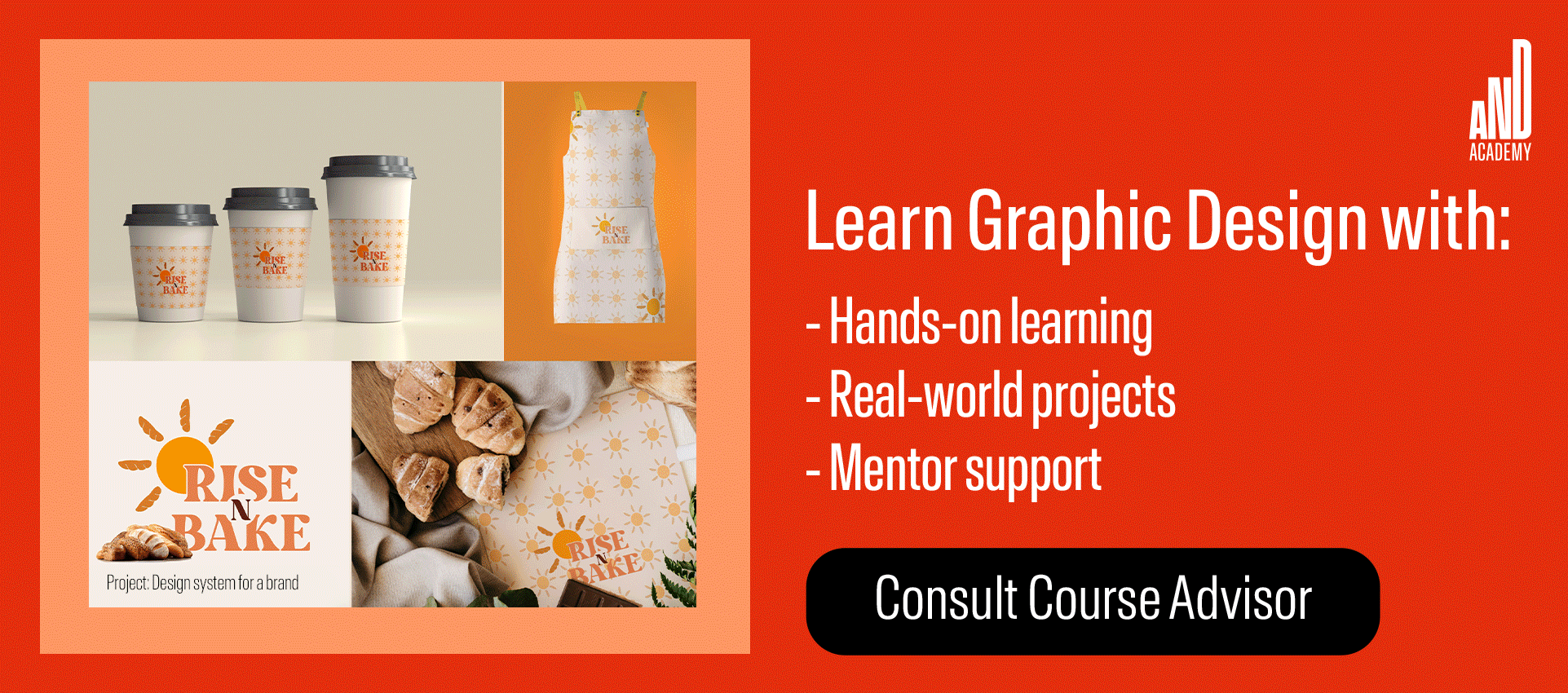
For a more in-depth look at the most important skills, refer to this guide: What Skills Does a Graphic Designer Need in 2023? A Complete Guide
What qualifications do you need to become a graphic designer? Is it possible to become a graphic designer without a degree?
You don’t need a specific qualification to become a graphic designer—and yes, it is absolutely possible to become a graphic designer without a degree.
What you do need, however, is a thorough and effective approach to learning graphic design. Most importantly, you need to master the essential practical skills in a way that gives you both the ability and the confidence to work in the field.
So, while you can rely on self-teaching up to a certain point, you will eventually need some form of expert guidance and a structured learning path—but this doesn’t mean you have to go to university and complete a full graphic design degree. Online courses and bootcamps are created for this very reason: to train job-ready graphic designers without years and years of study or hefty university fees.
Is it possible to transition to graphic design from an unrelated field?
Yes! It doesn’t matter what field of study or career path you’re coming from. As long as you can learn and demonstrate the most important graphic design skills, you can become a graphic designer.
With a reputable graphic design course, you can train as a graphic designer without any prior knowledge, experience, or qualifications. And, when you consider the graphic designer skill set, you’ll see that many of the essential skills are transferable from other fields—such as communication, collaboration, research, and problem-solving. You’re probably already much closer to becoming a graphic designer than you think.
Ultimately, employers in the field are looking at what you’re capable of—not what qualifications you have on paper or what you’ve done before. A degree (or lack thereof) won’t determine your chances of landing a graphic design role, and nor will it matter if you’re coming from an unrelated field.
The most important thing is that you learn the necessary skills and demonstrate them through your graphic design portfolio; all of which you can achieve through a mixture of self-study and a reputable graphic design course.
Fortunately, there are many high-quality graphic design courses to choose from. We’ve rounded up the 9 best graphic design courses and certifications here —check them out!

How to become a graphic designer: Your 5-step guide
So how do you go about mastering the essential skills and becoming a job-ready graphic designer? Here’s a 5-step plan to get you started.
- Learn graphic design theory and fundamentals
- Take a graphic design course
- Learn industry tools
- Apply your budding graphic design skills to real projects
- Build your graphic design portfolio
Let’s zoom in and show you how to tackle each step.
1. Learn graphic design theory and fundamentals
The first step is to build a broad foundational knowledge base. Your goal is to learn about the theory underpinning graphic design—including the basic elements of graphic design, and the main principles graphic designers follow, as well as colour theory, colour psychology, the role of typography, and visual branding.
Start with self-study, making the most of free resources such as blogs, YouTube videos, podcasts, and free graphic design courses. Here are some to start you off:
- The Vital Elements of Good Graphic Design by Una Healy Design
- Your Ultimate Guide to the History of Graphic Design by Amanda Walgrove
- Colour Theory in Graphic Design: A Brief Guide for Non-Designers by Fotor
- Fundamental Graphic Design Principles and How to Apply Them podcast hosted by Debbie Millman
- Design Matters by AND Academy
2. Take a graphic design course
If you’re new to graphic design and coming from an unrelated field, a graphic design course will be your gateway to success.
There are several things you’ll get from a course that you can’t get from self-study:
- Expert instruction and mentorship
- A structured, industry-relevant curriculum
- A supportive community of fellow learners
- The chance to apply your skills to practical projects
- Valuable feedback on your work
- Help building your graphic design portfolio
- Guidance when applying for jobs
All of those things are invaluable when it comes to successfully launching a career in graphic design. But bear in mind that not all graphic design courses are created equal.
For the best possible experience, look for a course that has you interacting with and learning from industry experts, working on practical projects, and one that offers career placement support.
With a reputable, high-quality course, your journey to becoming a graphic designer will be considerably smoother (and probably more enjoyable) than doing it alone.
3. Learn industry tools
Regardless of whether you’re applying for a junior, mid-level, or senior graphic design role, all employers will be looking for proficiency in certain tools.
You’ll learn industry-standard tools as part of your graphic design course, but it’s worth trying a few out and getting familiar with how they work before your course begins. Most programmes offer a free trial, and you’re only ever a Google search away from free video tutorials.
We’ve put together a round-up of the most popular graphic design tools and software , and here are some free tool-based tutorials worth checking out:
- Adobe Illustrator for Beginners by PR Learning Lab
- Adobe InDesign for Beginners by Envato Tuts+
- Getting started with Canva by Canva Design School
- Sketch for Beginners by Envato Tuts+
4. Apply your budding graphic design skills to real projects
Graphic design requires learning by doing, so it’s essential to get some hands-on experience. This will prepare you for your first graphic design job and provide material for your portfolio (another important piece of the jigsaw!).
Ideally, your chosen graphic design course will include practical project work. That way, you’ll have learning-by-doing built into the curriculum and have access to ready-made project briefs (as well as the opportunity to receive feedback on your work).
If your course doesn’t involve a practical component, consider a volunteering gig. Check platforms such as Vollie, RemoteHub, and Taproot Plus for opportunities to work on real graphic design projects.
You can also apply your skills to fictional projects. For example, graphic designer Meeta Panesar designed the concept packaging for a fictional chocolate brand, Le Temps Chocolate, with impressive results. Such projects are a great way to apply your skills and add to your portfolio if you’re struggling to find hands-on experience elsewhere.
5. Build your graphic design portfolio
You’ve learned the essential graphic design theory and mastered the most important practical skills. You’re proficient in industry tools and you’ve applied your skills to real (or hypothetical) projects. Now it’s time to bring it all together in your graphic design portfolio.
Your graphic design portfolio is a website (or other form of digital showcase) which presents projects you’ve worked on. It gives hiring managers great insight into your skills and your process—essentially proving that you’re a bona fide graphic designer ready to work in the field. Here are a few student projects by AND learners to give you an insight into building a portfolio:
- Print and Publication Design Project by Roohani Goyal
- Brand Identity Design Project by Sai Prasad Chandran
You’ll find everything you need to build your portfolio in this step-by-step guide: How To Create a Graphic Design Portfolio That Will Get You Hired (With Examples).
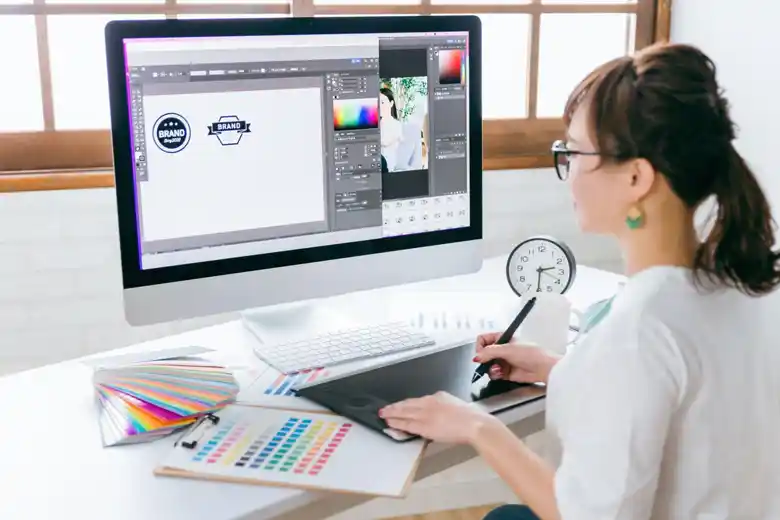
What next? Entering the graphic design job market
Once you’ve mastered the essential graphic design skills and created a professional portfolio, you’ll be ready for the next phase in your journey.
Here’s how to make the transition from “qualified” to “hired”:
Explore and familiarise yourself with the graphic design job market. There are many different job titles and career paths within the graphic design umbrella, so do your research and consider which direction you might like to take. Start with this in-depth guide to the top graphic design jobs (and their salaries).
Hone your application package. Is your resumé up-to-date and geared towards graphic design roles? How about your LinkedIn profile? Are you happy with your portfolio and ready to share it with prospective employers? Make sure you’re ready to market yourself as a graphic designer.
Prepare for your first graphic design interview(s). It’s essential that you’re able to talk confidently about your graphic design skills and show hiring managers why you’re a great candidate.
And that’s a wrap! You now know exactly how to become a graphic designer, which means there’s only one thing left to do. That’s right: it’s time to put our step-by-step guide into action. What are you waiting for?
Next steps
Ready to become a graphic designer? Here’s what you can do next:
- Watch this session by design veteran and AND’s Academic Head, Prachi Mittal, and our Course Lead, Soumya Tiwari.
- Talk to a course advisor to discuss how you can transform your career with one of our courses.
- Pursue our Graphic Design courses - all courses are taught through live, interactive classes by industry experts, and some even offer a Job Guarantee.
- Take advantage of the scholarship and funding options that come with our courses to overcome any financial hurdle on the path of your career transformation.
Note: All information and/or data from external sources is believed to be accurate as of the date of publication.

